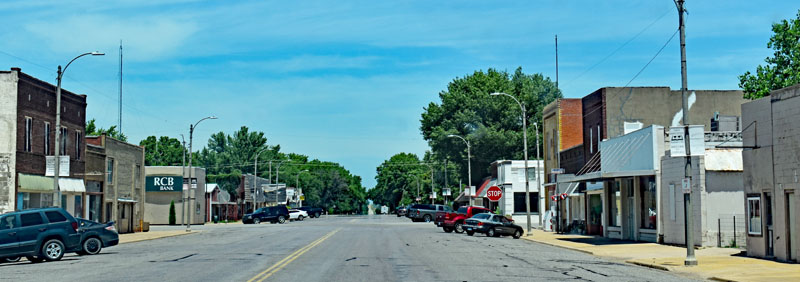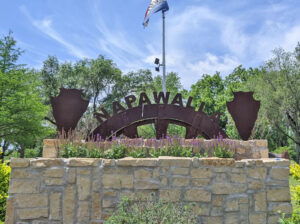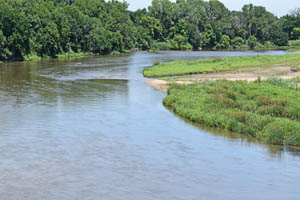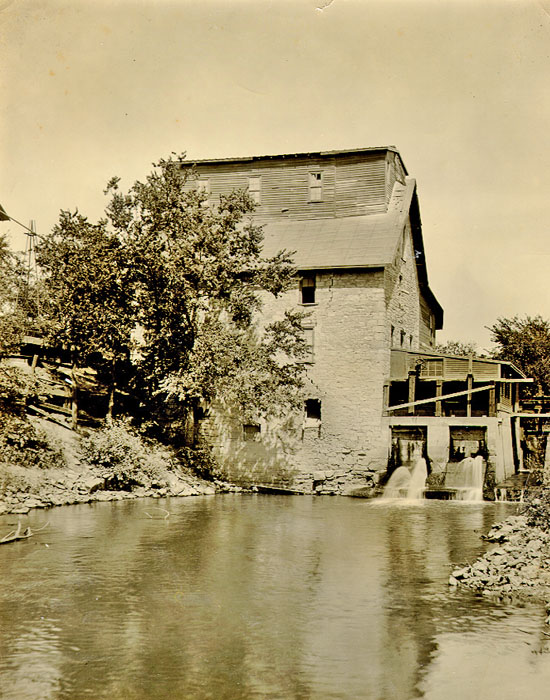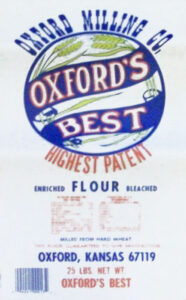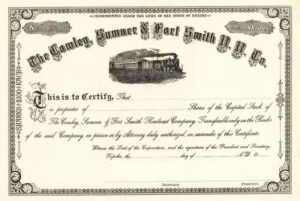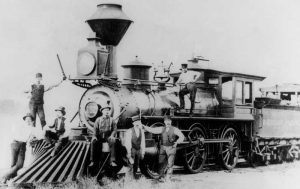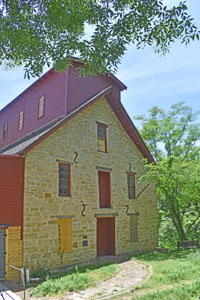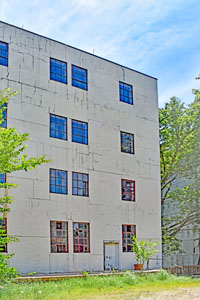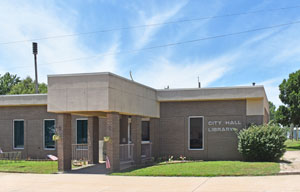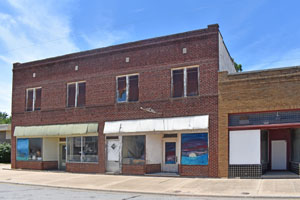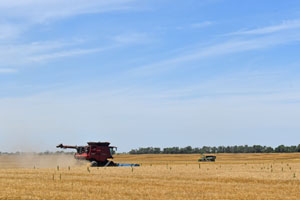Oxford, Kansas, is a small town in Sumner County. As of the 2020 census, the city’s population was 1,048, and its total area was 0.83 square miles, all land.

Osage Indians by George Catlin.
In 1869, the Great Osage tribe was encamped at Big Cottonwood Ford, near where the Ninnescah River empties into the Arkansas River. The camp was named for Chief Napawalla. When the Treaty of 1870 was signed, the Osage Tribe moved from the area, leaving behind thousands of acres to be purchased by settlers.
Charles A. Phillips, John J. Abeel, J.A. Moovill, and Perry Binkley settled in Oxford in December 1870. Binkley was the first to build a dug-out cabin at Big Cottonwood Crossing.
On February 1, 1871, Reverend W. Perkins preached the first sermon in the county in Perry Binkley’s dug-out.
On February 25, 1871, the Napawalla Town Company, which laid out the town of Napawalla where Oxford now stands, was formed. Arriving at the Arkansas River on February 26, they crossed over and bought the old town of Napawalla, which consisted of a single dug-out.
On February 28, Dr. P.A. Wood and Dr. C.R. Godfrey arrived, the former being the first resident physician to practice in the county.
The Oxford Town and Immigration Company was formed on March 6 and immediately set out for Napawalla. On March 31, the Town Company ordered a printing press.
A post office called Neptawah was established on April 5, 1871, with Lafe Binkley as postmaster. That month, O. Graff opened the first store, putting in a stock of goods valued at $3,500. On May 12, T.R. Donley and J.T. McMillan established a sawmill, and on May 28, J.T. McMillan and W.H. Mugford arrived with a pioneer printing press. The next day, J.T. Richmond began to manufacture native lumber.
The first newspaper issued in the county was the Oxford Times, established on June 22, 1871, by Mugford & Hughes. In December of the same year, it was sold to E.R. Trask, who continued the publication until March 1872, when J.H. Folks took the office and began the issue of the Oxford Press. In 1873, the paper was removed to Wellington, and the name changed to the Sumner County Press.
The Oxford Town and Emigration Company also laid out its town, and on June 23, 1871, the post office name was changed to Oxford, after Oxford University in England. T. E. Clark was the Postmaster.
The Methodist Church was organized on October 1, 1871, by Reverend B.F. Swartz, with a membership of 12. A stone church was begun in 1878 and completed in 1883 for $2,000. A small parsonage was also procured. A Sabbath school was started on the first Saturday of 1883. At that time, the society numbered 73.
On October 7, 1871, School District #1 was established southwest of the Arkansas River. The first schoolhouse was a one-room wooden building near the town center with Miss Minnie Whaley, the first teacher. It was the first schoolhouse southwest of the Arkansas River.
Oxford was incorporated as a city on October 17, 1879, with B. F. Smith serving as the first mayor.
The Presbyterian Church was organized in 1872 with a membership of 15. Reverend S.B. Fleming was ordained and held the pastorate for some time. A church building was erected in 1873 for about $2,000. It was the first church building south and west of the Arkansas River.
In March 1872, the Oxford Banner, run by Mugford & Hughes and owned by the Town Company, was discontinued, and its office was unceremoniously dealt with. The old press was cast out upon the prairie, and the type was boxed up and deposited in the back of a cobbler’s shop. The Town Company offered Folks & Ludlow the office and $400 in cash to run a weekly paper in Oxford for one year. The offer was accepted, and 53 weekly papers were issued when the proprietors took the outfit to Wellington and began the Sumner County Press.
On April 1, 1872, the township voted $10,000 in bonds to build a bridge across the river opposite the town. That year, a two-story stone school building was erected that was initially used for all classes.
The first railroad project meeting regarding the Independence, Colorado, Arizona, and Pacific Line was held in Oxford on November 14, 1872, but no action was taken until 1878.
The Oxford Enterprise was established in September 1873 by T.J. Hadley. It soon passed to Ludlow & Davidson, who continued until May 1874, when it was discontinued.
The Old Oxford Mill began to be built in 1874 by John M. Hewitt, a millman from Iowa, and D.N. Cook, a Sumner County Surveyor, who had been instrumental in choosing the best site for the mill.
A new stone schoolhouse was completed on December 31, 1874, and opened on May 10, 1875, with O. F. McKim as Principal.
Although the Oxford Mill owners, Hewitt and Cook, provided the leadership, the success of the mill project depended upon public support. A citizen group constructed the three-mile mill race parallel to the Arkansas River. The mill race was hand-dug at an estimated cost of $2,500. The water running through it provided the electricity necessary to run the mill. A small dam was built across the river to divert water into the mill race. It is about 40 feet wide and eight feet deep.
A local man, Mr. Sleigh, donated the stone for the dam, race, and mill from the quarry on his land just a mile from the mill site. A contract was signed on April 24, 1875, for erecting a large stone building, which was to be completed and filled with the necessary machinery for a flouring mill on or before January 1, 1876. Busard and Company were to complete the stonework by July. Initially, the mill was fitted with stone burrs and powered by a wooden water wheel.
In April 1875, the Sumner County Press announced: “Good News for Wheat Growers to have a first-class flouring mill. For two years—or since the experiment of wheat growing has proved a remarkable success—the question of mills has been of the utmost importance to the people of this county.” Prospective customers were enthusiastic about manufacturing the growing wheat crop into flour at home. At that time, grain had to.be hauled long distances in wagons to be sold or ground into flour in Sumner County.
“The Oxford Mills ground the first bushel of corn that was ground west of the Arkansas River and south of the Ninnescah River.”
“- The Winfield Courier, February 29, 1876
The Baptist Church was organized on April 6, 1875, with nine members. Reverend N.L. Rigby was the first preacher. A Sabbath school was organized on January 1, 1882.
The Christian Church was organized in February 1876, with a membership of 20. Reverend Joseph E. Cain became its pastor, and services were held in the Presbyterian Church.
John Blevins established the Oxford Independent newspaper on May 27, 1876. In November, it passed into the hands of Kelly & Benjamin and a few months later into those of J.L. Abbott, who published it until the fall of 1878, when it was removed to Harper County.
On July 29, 1876, the Sumner County Press mentioned that the Oxford Mill Company had secured the services of W.R. Bean, a miller from nearby Belle Plaine. The machinery arrived on September 9. Before the mill was put into operation, however, David Hardman replaced Bean as miller.
The three-story stone building with a basement is 40 feet long and 30 feet wide. The main part of the mill is constructed of rubble stone with its corners squared. Loading doors are centered in the west gable end wall at the second and third-floor levels. Inside the building, hewn timber posts and beams support the wooden floors. The water-powered mill was initially designed to accommodate four runs of burrs. The cost of the mill, race, and machinery was $15,000. The mill’s flour and cornmeal supported the slogan “Oxford’s Best.”
Oxford was incorporated as a city of the third class on October 17, 1876. Ben F. Smith was elected Mayor, Joseph Sleigh was police Judge, and George T. Walton was appointed City Clerk. On November 15, 1876, the town company was dissolved.
In the early years of the mill operation, D.N. Cook sold his interest to John Hewitt, who then sold it to David Hardman.
In 1878, William Thompson, originally from Canada, arrived in Wellington, Kansas. He worked in the machine business for F.G. Smith & Co. for a year before buying a half-interest in the Oxford Mills. Within no time, Thompson bought and shipped all kinds of grain from Wellington and Oxford. It probably has the best water power in the State.
In 1879, the Cowley, Sumner & Fort Smith Railroad arrived in Oxford. It was a branch of the Atchison, Topeka & Santa Fe Railroad.
A special election was held on July 1, 1879, to issue bonds to aid in building the Southern Kansas & Western Railway. The railway received $18,000 from Oxford, $20,000 from Wellington, and $16,000 from Dixon Township. This road, a Leavenworth, Lawrence & Galveston Railroad branch, was completed to Oxford on March 6, 1880, and to Wellington on July 27. On July 28, the first passenger train was run.
The Oxford Weekly Reflex, a six-column newspaper with Republican views, was established on December 11, 1879, under the management of Gridley & Stump. The paper was enlarged on February 2, 1880, and on March 3, Gridley withdrew. Stump continued the paper until September 2, 1880, when it collapsed.
In 1880, the Southern Kansas Western Railroad was completed to Oxford.
The Oxford Weekly was started as a six-column folio on December 16, 1880, by E. F. Widner, who had purchased the office of the defunct Reflex. However, the Weekly was short-lived and was discontinued on March 11, 1881.
The Catholic Church was gathered in 1881 by Father Kelly of Winfield, who preached at this point on the first Sabbath of each month. The society had 25 members in the early 1880s.
Ben F. Kelsey came to Oxford in 1886 to manage the mill and became a popular salesman for “Oxford’s Best” products. He would later lease the Oxford Mill from 1894 to 1900.
The Missouri Pacific Railroad was built through Oxford in 1887.
After 1890, flour milling in Kansas became more centralized and capital-intensive. Large steam-powered mills capable of producing 1,000 barrels of flour a day or more were built in major cities such as Leavenworth, Kansas City, Topeka, and Hutchinson. These mills sent flour to markets in the eastern United States and abroad.
High school classes were organized in 1895-96, and a tower was added to the school building to hold classes.
The small Oxford Mill survived into the 20th century. Relatively cheap power, good management, and a loyal clientele were some factors that made it profitable for the Oxford Mill to continue operating. The stone mill was then modified to accommodate a modern reinforced concrete sluice gate arrangement.
The Mitchell family owned the Oxford Mill between 1900 and 1910.
In August 1909, the first telephone switchboard was installed.
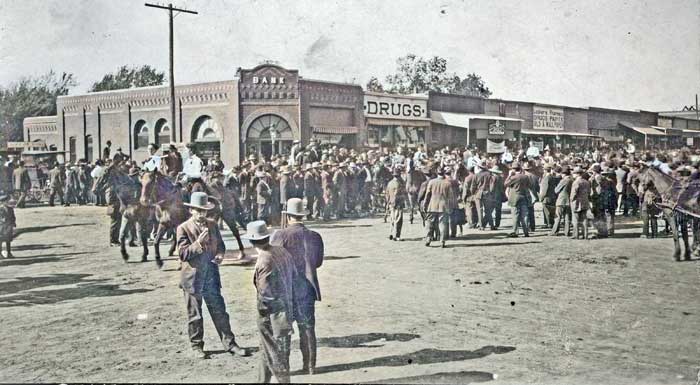
Oxford, Kansas, October 25, 1913 during A.H.T.A. Day. Touch of color by LOA.
In 1910, Oxford was located on the Missouri Pacific and the Atchison, Topeka, and Santa Fe Railroads. At that time, it had a bank, a flour mill, a weekly newspaper called the Register, many retail establishments, good schools and churches, telegraph and express offices, and an international money order post office with two rural routes. Its population was 624.
That year, Charles Champeny and B.F. Fisher purchased the mill. The stones were replaced by a new roller system designed to provide a more satisfactory milling method for increased production of hard winter wheat in Kansas. Knowing that farmers preferred their wheat to be custom ground, the mill advertised its services, and business flourished. Champeny worked it until his death, and his family has maintained its interest in it ever since.
The Midland Valley Railroad was established in Oxford in 1911.
In 1913, a new building for both a grade and high school was built.
Fisher sold his interest in 1916, and the mill remained inactive until 1918. The Champenys added an elevator building to house modern roller process machinery that year. The mill has remained in the family ever since.
The original water wheel at the Old Oxford Mill was replaced in 1923.
A new high school began to be built in 1927, and the first classes were held in the fall of 1929.
In January 1930, the grade school burned down, and a new school was soon erected.
In 1933, the Oxford Mill was grinding grain “on shares.” when farmers brought in a 60-pound bushel of wheat, they received 34 pounds of flour, with the rest going to the miller. Because of the depressed economic conditions, some farmers came from as far as 200 miles away to exchange their wheat for flour.
In the 1930s, oil production increased the town’s population. Soon, the town even had an opera house, and Oxford was a busy shipping and transportation center for many years. Three railroads ran regular schedules. Gradually, oil production lessened, and people were transferred to other areas after World War II.
“Oxford’s Best” flour was produced in the mill until 1935 and sold to customers in the surrounding region. At that time, Charles Champeny and his two sons built a new mill northwest of the old stone structure, and the milling machinery was moved to the new site. In 1939, a generator was installed above the water turbine, and the mill continued using electricity generated. The new mill produced all-purpose flour, whole wheat flour, corn meal, and stock feed.
The Missouri Pacific Railroad was removed after the big flood in the late 1940s.
The newest high school was completed in 1967.
The Midland Valley Railroad was removed in 1969.
In 1973, the turbine at the Old Oxford Mill broke down, and the building remained unused. The city generating plant then provided power for the modern mill.
Beginning in the early 1970s, especially in 1975, the mill owners attempted to stabilize the deteriorating condition of the unoccupied buildings. They repaired the foundation and roof and replaced and repaired sections of the interior wooden walls and floors. However, by 1977, the mill was no longer profitable and had ceased operations.
In June 1980, the town of Oxford received an $8,000 loan from the Department of Energy for a feasibility study of the mill site’s electrical hydrogeneration potential. A plan was proposed to repair two 70-year-old turbines in the original mill building, build up the main diversion dam across the river, place new gates in a smaller dam controlling the flow of the millrace, dredge the channel, and repair the mill’s foundation. M.E. Jenkins, chairman of a local committee working on the project, commented, “Not only would it produce power, but I would hope one day the old mill could be refurbished and become a tourist attraction.”
The Old Mill was placed on the National Historical Register on April 26, 1982. The Old Oxford Mill is located at 170 N. Old Mill Road in Oxford, Kansas.
By the 1980s, the Old Oxford Mill had fallen into disrepair. In 1988, Wallace Champeny, grandson of Charles Champeny, invited architect Gene Ernst from Kansas State University to make plans for restoring the old mill. Champeny and his friend and former classmate, Hal Ross, then began restoring the mill under the direction of Gene Ernst. The men substantially rebuilt the structure, replacing old posts, beams, joists, flooring, and the original grinding stones. The headhouse was also refurbished. When complete, corn and wheat were again milled on a reduced schedule of two or three days a week, turning out about ten tons of finished wheat and corn products weekly.
In 1997, the mill ceased operation for good and began a new life as a restaurant. However, it was never very successful. In 2008, it was taken over by the Old Oxford Mill Center for Entrepreneurship, a joint venture between Cowley College and the local public school district. Students assisted in operating the restaurant, which was open for Sunday lunch and private parties. Unfortunately, the restaurant closed during the 2020 COVID-19 pandemic and never reopened.
Oxford’s population peaked in 2000 at 1,173.
© Kathy Alexander/Legends of Kansas, June 2024.
Also See:
Kansas Counties
Kansas Destinations
Sources
Blackmar, Frank W.; Kansas: A Cyclopedia of State History, Vol I; Standard Publishing Company, Chicago, IL 1912.
City of Oxford
Greg Disch Photography
National Register – Old Oxford Mill
Sumner NewsCow
Wikipedia – Oxford
Wikipedia – Old Oxford Mill

